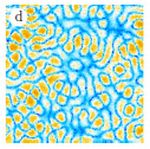EPJ B Highlight - Conductor turned insulator amid disorder
- Details
- Published on 02 December 2015

Study analyses how disorder in the way atoms are connected in a material influences electric conductivity
Some materials that are inherently disordered display unusual conductivity, sometimes behaving like insulators and sometimes like conductors. Physicists have now analysed the conductivity in a special class of disordered materials. Martin Puschmann from the Technical University Chemnitz, Germany, and colleagues have demonstrated that electrons in the materials studied display a multifractal spatial structure at the transition between conductive and insulating behaviour. These findings have just been published by in EPJ B.
The disordered materials under scrutiny in this study consist of networks of atoms that are connected randomly, in contrast to the regular alignment of atoms within a crystal. They are found, for example, in amorphous solids such as glass as well as in biological tissue made of an assembly of cells. The random organisation of the atoms dramatically affects the electrical conductivity at the quantum scale.
To study the specific characteristics of electric conductivity, the authors performed large-scale computer simulations. They first created model lattices with randomly positioned atoms and connections. They then computed the function describing how the electrons move on these lattices—known as quantum-mechanical wave functions. If these wave functions spread out, the material is a conductor, if they remain localised, it is an insulator.
Incidentally, over fifty years ago, Philip Anderson showed that impurities and defects can turn materials from metallic-style conductors into insulators.
When the material is right at the threshold between conductor and insulator, the electron wave functions have a most peculiar spatial structure, as Puschmann and colleagues show. Indeed, they are multi fractals-- interwoven sets of different fractals, each with its own dimension. By computing and analysing the spectrum of these dimensions, they obtained a fingerprint of its spatial structure. This, in turn, opened the door to understanding how the disorder turns the material from conductor to insulator.
M. Puschmann, P. Cain, M. Schreiber, and T. Vojta (2015), Multifractal analysis of electronic states on random Voronoi-Delaunay lattices, Eur. Phys. J. B 88:314, DOI: 10.1140/epjb/e2015-60698-7




